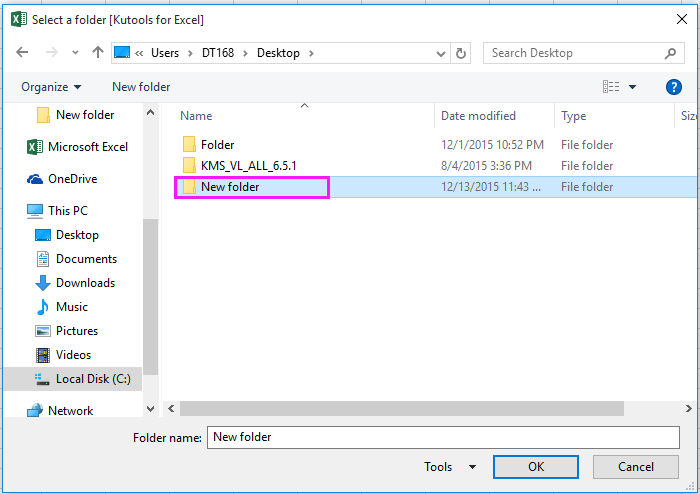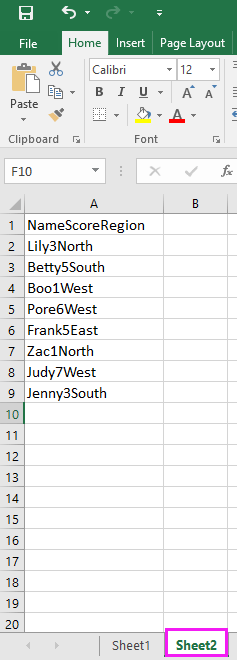Excel에서 여러 개의 csv/텍스트/xml 파일을 빠르게 일괄 가져오는 방법은 무엇입니까?
Excel에서 통합 문서를 csv 파일, 텍스트 파일 또는 xml 파일로 저장하려고 시도했을 수 있습니다. 하지만 폴더에서 여러 csv/텍스트/xml 파일을 통합 문서나 워크시트로 가져온 적이 있습니까? 이 문서에서는 이를 빠르게 일괄 가져오는 몇 가지 방법을 소개합니다.
VBA를 사용하여 폴더에서 여러 텍스트 파일을 통합 문서의 각 워크시트로 가져오기
폴더에서 텍스트 파일을 통합 문서로 가져오려면 아래 VBA를 사용하여 빠르게 처리할 수 있습니다.
1. 빈 통합 문서를 열고 Alt + F11 키를 눌러 Microsoft Visual Basic for Applications 창을 엽니다.
2. 삽입 > 모듈을 클릭하고 VBA를 모듈 창에 붙여넣습니다.
VBA: 폴더에서 모든 텍스트 파일을 통합 문서로 가져오기
Sub LoadPipeDelimitedFiles()
'UpdatebyKutoolsforExcel20151214
Dim xStrPath As String
Dim xFileDialog As FileDialog
Dim xFile As String
Dim xCount As Long
On Error GoTo ErrHandler
Set xFileDialog = Application.FileDialog(msoFileDialogFolderPicker)
xFileDialog.AllowMultiSelect = False
xFileDialog.Title = "Select a folder [Kutools for Excel]"
If xFileDialog.Show = -1 Then
xStrPath = xFileDialog.SelectedItems(1)
End If
If xStrPath = "" Then Exit Sub
Application.ScreenUpdating = False
xFile = Dir(xStrPath & "\*.txt")
Do While xFile <> ""
xCount = xCount + 1
Sheets(xCount).Select
With ActiveSheet.QueryTables.Add(Connection:="TEXT;" _
& xStrPath & "\" & xFile, Destination:=Range("A1"))
.Name = "a" & xCount
.FieldNames = True
.RowNumbers = False
.FillAdjacentFormulas = False
.PreserveFormatting = True
.RefreshOnFileOpen = False
.RefreshStyle = xlInsertDeleteCells
.SavePassword = False
.SaveData = True
.AdjustColumnWidth = True
.RefreshPeriod = 0
.TextFilePromptOnRefresh = False
.TextFilePlatform = 437
.TextFileStartRow = 1
.TextFileParseType = xlDelimited
.TextFileTextQualifier = xlTextQualifierDoubleQuote
.TextFileConsecutiveDelimiter = False
.TextFileTabDelimiter = False
.TextFileSemicolonDelimiter = False
.TextFileCommaDelimiter = False
.TextFileSpaceDelimiter = False
.TextFileOtherDelimiter = "|"
.TextFileColumnDataTypes = Array(1, 1, 1)
.TextFileTrailingMinusNumbers = True
.Refresh BackgroundQuery:=False
xFile = Dir
End With
Loop
Application.ScreenUpdating = True
Exit Sub
ErrHandler:
MsgBox "no files txt", , "Kutools for Excel"
End Sub3. F5 키를 누르거나 실행 버튼을 클릭하여 VBA를 실행하고, 나타나는 대화 상자에서 텍스트 파일을 가져올 폴더를 선택합니다. 스크린샷 보기:

4. 확인을 클릭하면 선택한 폴더의 각 텍스트 파일이 활성 통합 문서의 한 워크시트로 가져옵니다. 스크린샷 보기:



Kutools AI로 엑셀의 마법을 풀다
- 스마트 실행: 셀 작업 수행, 데이터 분석 및 차트 생성 - 간단한 명령어로 모든 것을 처리합니다.
- 사용자 정의 수식: 작업을 간소화하기 위한 맞춤형 수식을 생성합니다.
- VBA 코딩: 손쉽게 VBA 코드를 작성하고 실행합니다.
- 수식 해석: 복잡한 수식도 쉽게 이해할 수 있습니다.
- 텍스트 번역: 스프레드시트 내 언어 장벽을 허물어 보세요.
VBA를 사용하여 폴더에서 여러 csv 파일을 단일 시트로 가져오기
폴더의 모든 csv 파일을 단일 시트로 가져오려면 아래 VBA 코드를 사용할 수 있습니다.
1. 빈 워크시트를 열고 Alt + F11 키를 눌러 Microsoft Visual Basic for Applications 창을 엽니다.
2. 삽입 > 모듈을 클릭하고 새 모듈 창에 아래 VBA를 붙여넣습니다.
VBA: 폴더에서 csv 파일을 하나의 워크시트로 가져오기
Sub ImportCSVsWithReference()
'UpdatebyKutoolsforExcel20151214
Dim xSht As Worksheet
Dim xWb As Workbook
Dim xStrPath As String
Dim xFileDialog As FileDialog
Dim xFile As String
On Error GoTo ErrHandler
Set xFileDialog = Application.FileDialog(msoFileDialogFolderPicker)
xFileDialog.AllowMultiSelect = False
xFileDialog.Title = "Select a folder [Kutools for Excel]"
If xFileDialog.Show = -1 Then
xStrPath = xFileDialog.SelectedItems(1)
End If
If xStrPath = "" Then Exit Sub
Set xSht = ThisWorkbook.ActiveSheet
If MsgBox("Clear the existing sheet before importing?", vbYesNo, "Kutools for Excel") = vbYes Then xSht.UsedRange.Clear
Application.ScreenUpdating = False
xFile = Dir(xStrPath & "\" & "*.csv")
Do While xFile <> ""
Set xWb = Workbooks.Open(xStrPath & "\" & xFile)
Columns(1).Insert xlShiftToRight
Columns(1).SpecialCells(xlBlanks).Value = ActiveSheet.Name
ActiveSheet.UsedRange.Copy xSht.Range("A" & Rows.Count).End(xlUp).Offset(1)
xWb.Close False
xFile = Dir
Loop
Application.ScreenUpdating = True
Exit Sub
ErrHandler:
MsgBox "no files csv", , "Kutools for Excel"
End Sub3. F5 키를 누르거나 실행 버튼을 클릭하여 VBA를 실행하고, 나타나는 대화 상자에서 모든 csv 파일을 가져올 폴더를 선택합니다. 스크린샷 보기:

4. 확인을 클릭하면 활성 워크시트의 내용을 가져오기 전에 지울지 묻는 대화 상자가 나타납니다. 여기서 예를 클릭합니다. 스크린샷 보기:

예를 클릭하면 선택한 폴더의 모든 csv 파일이 현재 시트로 가져와지고, 데이터는 A열부터 오른쪽으로 배치됩니다. 스크린샷 보기:


팁: csv 파일을 워크시트에 가로로 배치하려면 아래 VBA를 사용할 수 있습니다.
Sub ImportCSVsWithReferenceI()
'UpdatebyKutoolsforExcel20151214
Dim xSht As Worksheet
Dim xWb As Workbook
Dim xStrPath As String
Dim xFileDialog As FileDialog
Dim xFile As String
Dim xCount As Long
On Error GoTo ErrHandler
Set xFileDialog = Application.FileDialog(msoFileDialogFolderPicker)
xFileDialog.AllowMultiSelect = False
xFileDialog.Title = "Select a folder [Kutools for Excel]"
If xFileDialog.Show = -1 Then
xStrPath = xFileDialog.SelectedItems(1)
End If
If xStrPath = "" Then Exit Sub
Set xSht = ThisWorkbook.ActiveSheet
If MsgBox("Clear the existing sheet before importing?", vbYesNo, "Kutools for Excel") = vbYes Then
xSht.UsedRange.Clear
xCount = 1
Else
xCount = xSht.Cells(3, Columns.Count).End(xlToLeft).Column + 1
End If
Application.ScreenUpdating = False
xFile = Dir(xStrPath & "\" & "*.csv")
Do While xFile <> ""
Set xWb = Workbooks.Open(xStrPath & "\" & xFile)
Rows(1).Insert xlShiftDown
Range("A1") = ActiveSheet.Name
ActiveSheet.UsedRange.Copy xSht.Cells(1, xCount)
xWb.Close False
xFile = Dir
xCount = xSht.Cells(3, Columns.Count).End(xlToLeft).Column + 1
Loop
Application.ScreenUpdating = True
Exit Sub
ErrHandler:
MsgBox "no files csv", , "Kutools for Excel"
End Sub 
VBA를 사용하여 폴더에서 여러 xml 파일을 단일 시트로 가져오기
폴더의 모든 XML 파일을 단일 시트로 가져오려면 아래 VBA 코드를 사용할 수 있습니다.
1. 가져온 데이터를 배치할 빈 시트를 선택하고 Alt + F11 키를 눌러 Microsoft Visual Basic for Applications 창을 엽니다.
2. 삽입 > 모듈을 클릭하고 VBA 코드를 모듈 창에 붙여넣습니다.
VBA: 폴더에서 XML 파일을 워크시트로 가져오기.
Sub From_XML_To_XL()
'UpdatebyKutoolsforExcel20151214
Dim xWb As Workbook
Dim xSWb As Workbook
Dim xStrPath As String
Dim xFileDialog As FileDialog
Dim xFile As String
Dim xCount As Long
On Error GoTo ErrHandler
Set xFileDialog = Application.FileDialog(msoFileDialogFolderPicker)
xFileDialog.AllowMultiSelect = False
xFileDialog.Title = "Select a folder [Kutools for Excel]"
If xFileDialog.Show = -1 Then
xStrPath = xFileDialog.SelectedItems(1)
End If
If xStrPath = "" Then Exit Sub
Application.ScreenUpdating = False
Set xSWb = ThisWorkbook
xCount = 1
xFile = Dir(xStrPath & "\*.xml")
Do While xFile <> ""
Set xWb = Workbooks.OpenXML(xStrPath & "\" & xFile)
xWb.Sheets(1).UsedRange.Copy xSWb.Sheets(1).Cells(xCount, 1)
xWb.Close False
xCount = xSWb.Sheets(1).UsedRange.Rows.Count + 2
xFile = Dir()
Loop
Application.ScreenUpdating = True
xSWb.Save
Exit Sub
ErrHandler:
MsgBox "no files xml", , "Kutools for Excel"
End Sub3. 실행 버튼을 클릭하거나 F5 키를 눌러 VBA를 실행하고, 나타나는 대화 상자에서 폴더를 선택합니다. 스크린샷 보기:

4. 확인을 클릭하면 선택한 폴더의 모든 XML 파일이 활성 시트로 가져옵니다.
Kutools for Excel을 사용하여 여러 xml/csv 파일을 시트 또는 통합 문서로 가져오거나 결합하기
VBA에 익숙하지 않다면 걱정하지 마세요. 여기 Kutools for Excel이라는 유용한 도구를 소개합니다. 강력한 결합 기능을 통해 여러 xml 파일이나 csv 파일을 하나의 통합 문서 또는 하나의 Excel 시트로 빠르게 결합할 수 있습니다.
Kutools for Excel 설치 후 아래와 같이 하십시오. (지금 Kutools for Excel 무료 다운로드!)
1. Excel을 실행하고 클릭하세요. Kutools Plus > 결합. 스크린샷 보기:
2. 그리고 결합 1단계 대화 상자에서 필요에 따라 구분 옵션을 선택하세요. 스크린샷 보기:
3. 클릭 다음 으로 이동 결합 2단계, 클릭 추가 다양한 폴더에서 파일을 추가하거나 하나의 폴더에서 파일을 추가하여 통합 문서 목록에 추가하고, 또한 결합하려는 시트를 워크시트 오른쪽 섹션 목록에서 지정할 수도 있습니다. 스크린샷 보기:
4. 클릭 다음 마지막 단계로 이동 결합, 결합 옵션을 지정할 수 있습니다.
5. 클릭 완료, 새롭게 결합된 결과를 저장할 위치를 선택하라는 대화 상자가 나타납니다. 스크린샷 보기:
6. 클릭 저장. 추가된 모든 시트가 새로운 단일 시트로 결합되었습니다.
팁: 결합 기능을 사용하면 여러 폴더 또는 하나의 폴더에서 여러 CSV 파일을 하나의 시트 또는 통합 문서로 결합할 수도 있습니다.
Kutools for Excel을 사용하여 각 시트를 csv/텍스트/pdf로 폴더에 내보내기
각 시트를 csv/텍스트/pdf 파일로 폴더에 내보내려면 Kutools for Excel의 통합 문서 분리 기능이 도움이 될 수 있습니다.
무료 다운로드 및 설치 후 Kutools for Excel, 아래와 같이 하십시오:
1. 워크시트를 내보낼 통합 문서를 열고 Kutools Plus > 통합 문서 > 통합 문서 분리 클릭. 스크린샷 보기:

2. 통합 문서 분리 대화 상자에서 내보낼 시트 이름을 체크할 수 있으며, 기본적으로 모든 시트가 체크되어 있고, 저장 형식 지정을 체크하고 아래 드롭다운 목록에서 저장할 파일 형식을 선택합니다. 스크린샷 보기:

3. 분리 클릭하고 분리된 파일을 저장할 폴더를 찾아 폴더 대화 상자에서 선택합니다. 스크린샷 보기:

4. 확인을 클릭하면, 이제 선택한 폴더에 체크된 모든 시트가 새 파일 형식으로 내보내집니다.
관련 기사:
- Excel에서 하이퍼링크를 일반 텍스트로 변환하는 방법은 무엇입니까?
- Excel에서 십진수를 이진수/팔진수/십육진수로 변환하거나 그 반대로 변환하는 방법은 무엇입니까?
- Excel에 실시간 환율을 삽입하는 방법은 무엇입니까?
최고의 오피스 생산성 도구
| 🤖 | Kutools AI 도우미: 데이터 분석에 혁신을 가져옵니다. 방법: 지능형 실행 | 코드 생성 | 사용자 정의 수식 생성 | 데이터 분석 및 차트 생성 | Kutools Functions 호출… |
| 인기 기능: 중복 찾기, 강조 또는 중복 표시 | 빈 행 삭제 | 데이터 손실 없이 열 또는 셀 병합 | 반올림(수식 없이) ... | |
| 슈퍼 LOOKUP: 다중 조건 VLOOKUP | 다중 값 VLOOKUP | 다중 시트 조회 | 퍼지 매치 .... | |
| 고급 드롭다운 목록: 드롭다운 목록 빠르게 생성 | 종속 드롭다운 목록 | 다중 선택 드롭다운 목록 .... | |
| 열 관리자: 지정한 수의 열 추가 | 열 이동 | 숨겨진 열의 표시 상태 전환 | 범위 및 열 비교 ... | |
| 추천 기능: 그리드 포커스 | 디자인 보기 | 향상된 수식 표시줄 | 통합 문서 & 시트 관리자 | 자동 텍스트 라이브러리 | 날짜 선택기 | 데이터 병합 | 셀 암호화/해독 | 목록으로 이메일 보내기 | 슈퍼 필터 | 특수 필터(굵게/이탤릭/취소선 필터 등) ... | |
| 15대 주요 도구 세트: 12 가지 텍스트 도구(텍스트 추가, 특정 문자 삭제, ...) | 50+ 종류의 차트(간트 차트, ...) | 40+ 실용적 수식(생일을 기반으로 나이 계산, ...) | 19 가지 삽입 도구(QR 코드 삽입, 경로에서 그림 삽입, ...) | 12 가지 변환 도구(단어로 변환하기, 통화 변환, ...) | 7 가지 병합 & 분할 도구(고급 행 병합, 셀 분할, ...) | ... 등 다양 |
Kutools for Excel과 함께 엑셀 능력을 한 단계 끌어 올리고, 이전에 없던 효율성을 경험하세요. Kutools for Excel은300개 이상의 고급 기능으로 생산성을 높이고 저장 시간을 단축합니다. 가장 필요한 기능을 바로 확인하려면 여기를 클릭하세요...
Office Tab은 Office에 탭 인터페이스를 제공하여 작업을 더욱 간편하게 만듭니다
- Word, Excel, PowerPoint에서 탭 편집 및 읽기를 활성화합니다.
- 새 창 대신 같은 창의 새로운 탭에서 여러 파일을 열고 생성할 수 있습니다.
- 생산성이50% 증가하며, 매일 수백 번의 마우스 클릭을 줄여줍니다!
모든 Kutools 추가 기능. 한 번에 설치
Kutools for Office 제품군은 Excel, Word, Outlook, PowerPoint용 추가 기능과 Office Tab Pro를 한 번에 제공하여 Office 앱을 활용하는 팀에 최적입니다.
- 올인원 제품군 — Excel, Word, Outlook, PowerPoint 추가 기능 + Office Tab Pro
- 설치 한 번, 라이선스 한 번 — 몇 분 만에 손쉽게 설정(MSI 지원)
- 함께 사용할 때 더욱 효율적 — Office 앱 간 생산성 향상
- 30일 모든 기능 사용 가능 — 회원가입/카드 불필요
- 최고의 가성비 — 개별 추가 기능 구매 대비 절약